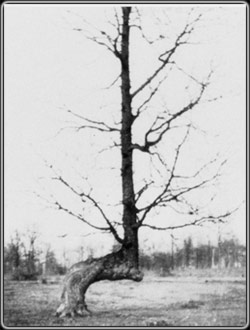Trail Marker Trees
By Taylor on November 21, 2012 in Blog
 Especially in Iowa, trees are a phenomenal piece of the state’s natural landscape. We’ve shared INHF’s personal connection to Iowa’s state tree, the oak, but have you ever wondered about the history of the trees around you?
Especially in Iowa, trees are a phenomenal piece of the state’s natural landscape. We’ve shared INHF’s personal connection to Iowa’s state tree, the oak, but have you ever wondered about the history of the trees around you?
Before the colonists ever arrived in America, many tribes of Native Americans used trees and other elements of the natural world to communicate with one another.
But we think one of the most fascinating practices was the use of trail marker trees. These trees were culturally modified to grow at a horizontal plane, signaling the way out of a forest or directing an individual to a nearby stream.
Due to their flexibility as young trees, most of the trees used as trail markers were oaks or maples. After the tree was bent it was then fastened or held down with straps or some sort of weight to create the distinct L-shape of a trail marker tree.
Interested in learning more? Check out Dennis Downe’s book about trail marker trees, “Native American Trail Marker Trees: Marking Paths through the Wilderness.” Downe also is the founder of the Great Lakes Trail Marker Tree Society.
